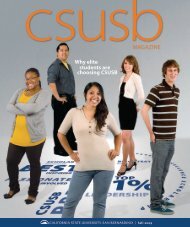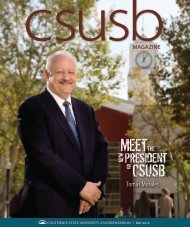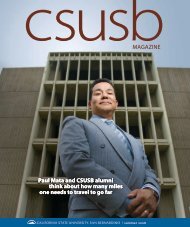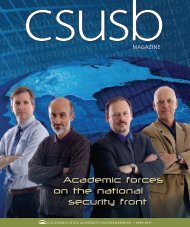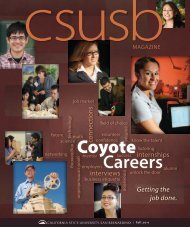CalMagSpr05 ind.indd - CSUSB Magazine - California State ...
CalMagSpr05 ind.indd - CSUSB Magazine - California State ...
CalMagSpr05 ind.indd - CSUSB Magazine - California State ...
- TAGS
- csusb
- magazine.csusb.edu
Create successful ePaper yourself
Turn your PDF publications into a flip-book with our unique Google optimized e-Paper software.
Already strapped<br />
by a shortage of<br />
teachers, America’s<br />
last, formidable<br />
educational frontier<br />
is its prisons,<br />
where crime and<br />
punishment are<br />
being addressed<br />
with books.<br />
Carolyn Eggleston and Thom Gehring (picture far left) offer a couple of tips to a <strong>California</strong> Youth Authority inmate learning how to<br />
prepare a resume. The guard tower at the detention center (top). Inmates learn on reasonably up-to-date computer equipment, and seating in<br />
classrooms around the facility varies from schoolroom desks to simple metal benches (middle) to picnic tables. Eggleston and Gehring visit with<br />
inmates in a welding room, where the two educators are taken for safety precautions after prison officials declare a lockdown (bottom).<br />
should be punished everyday,” said Eggleston, who, in 1975 became an educational specialist and diagnostician<br />
for the Department of Correctional Education in Virginia. And it doesn’t help, she added, that no<br />
states have a standard for teaching in correctional facilities.<br />
That’s where the university’s Center for the Study of Correctional Education and associations such as<br />
the Correctional Education Association, based near Washington, D.C., come in. They’ve created standards<br />
and programs, conducted studies and pulled together other mentoring resources to support that wing<br />
of the teaching profession, Eggleston said. That work is critical, because, for many correctional educators,<br />
teaching at a prison or juvenile facility probably is not the profession to which they aspire. Indeed.<br />
Eggleston got into the field by applying for a better paying job. Gehring said he took the job because that<br />
was all that was available. And now the two f<strong>ind</strong> themselves in what has become for them an “avocation.”<br />
They look at different areas of correctional education. Eggleston focuses on the special education<br />
aspect of correctional education, and is the former publisher and editor of the Journal of Correctional<br />
Education. Meanwhile, Gehring has focused on the history of correctional education and prison reform,<br />
and currently serves as the historian for the Correctional Education Association. The correctional education<br />
center offers coursework toward a master’s degree in correctional education that is tailored specifically<br />
for teaching in correctional facilities. The center also has two senior fellows who are instructors in<br />
<strong>CSUSB</strong>’s College of Education, professors Richard Ashcroft and Randall Wright.<br />
But there is one constant in correctional education: Instructors have to be constantly aware — aware<br />
of their surroundings, aware of the potential for harm as a matter of survival. “It can be very intimidating<br />
going beh<strong>ind</strong> bars to teach. Walking through and hearing three or four gates slam beh<strong>ind</strong> you is a difficult<br />
thing to deal with,” Eggleston said. “Remember, these people didn’t get locked up because they couldn’t do<br />
fractions.” Yet many of the prisoners in correctional education share one thing in common with most students<br />
at a typical college — the desire to learn. At most facilities, the inmates in classes want to be there.<br />
They could earn money working at jobs in the prison, but instead choose to be in a classroom, Gehring<br />
said. “School is looked upon like a job assignment, but they do not get paid for attending.”<br />
That desire for an education can help not only the inmate but also society in general, according to a<br />
study by Audrey Bazos and Jessica Hausman from the UCLA School of Public Policy and Social Research.<br />
The study compared the rates of rearrest, reconviction and reincarceration of inmates in Maryland,<br />
Minnesota and Ohio compared to those inmates who did not participate in educational programs three<br />
years after their release. The comparison found that $1 million spent to incarcerate prevented about 350<br />
crimes, while the same amount of money spent on correctional education prevented about 600 crimes.<br />
15<br />
Spring/Summer 2005 <strong>CSUSB</strong>



